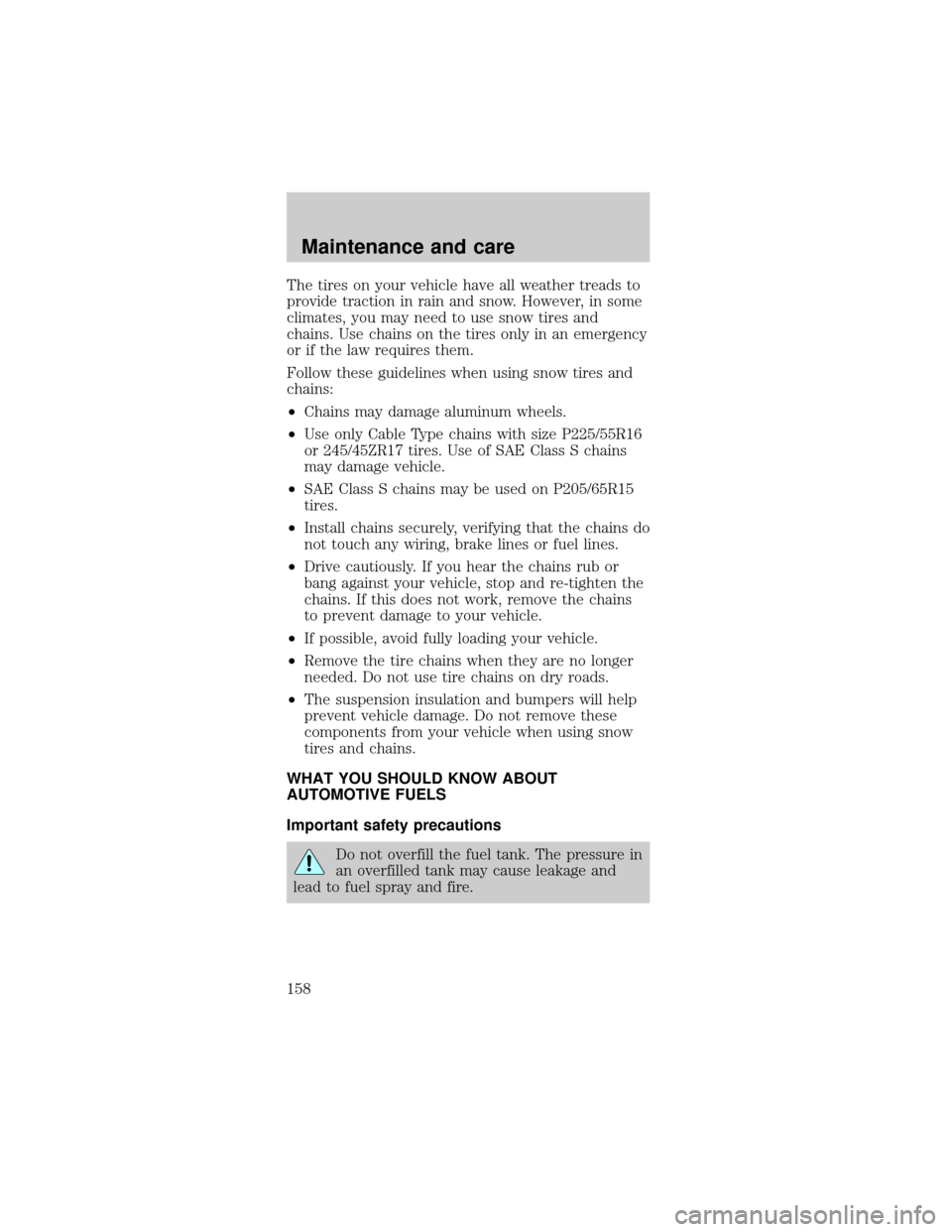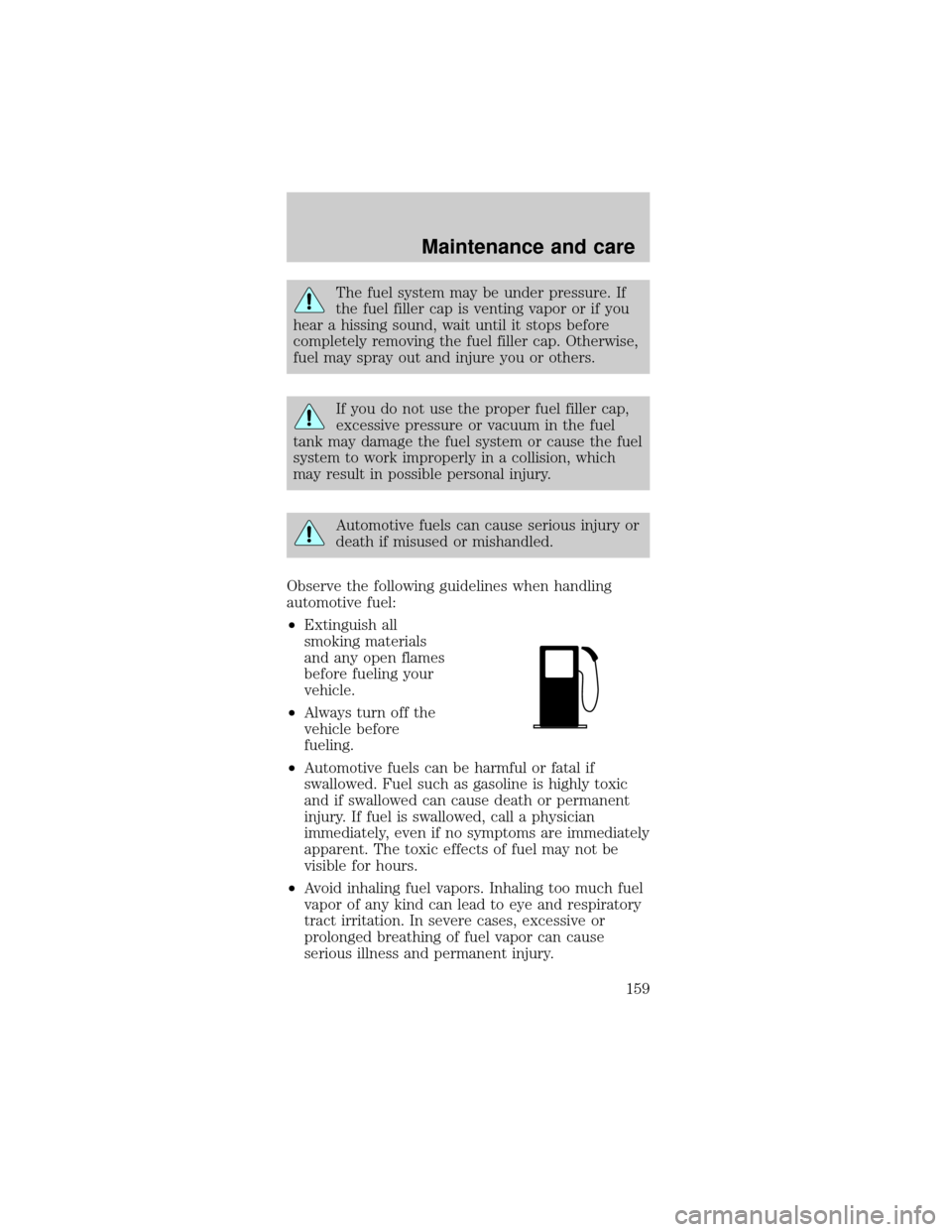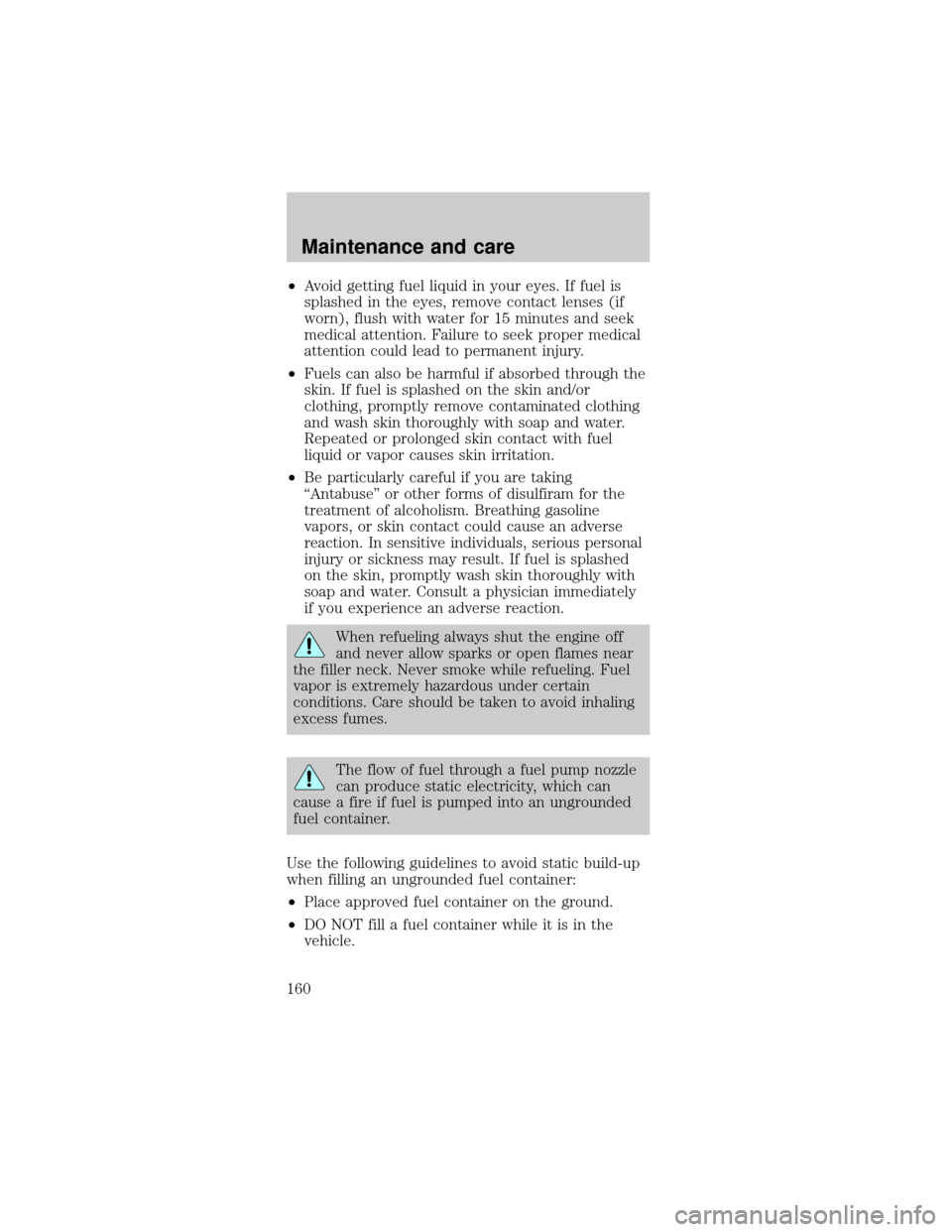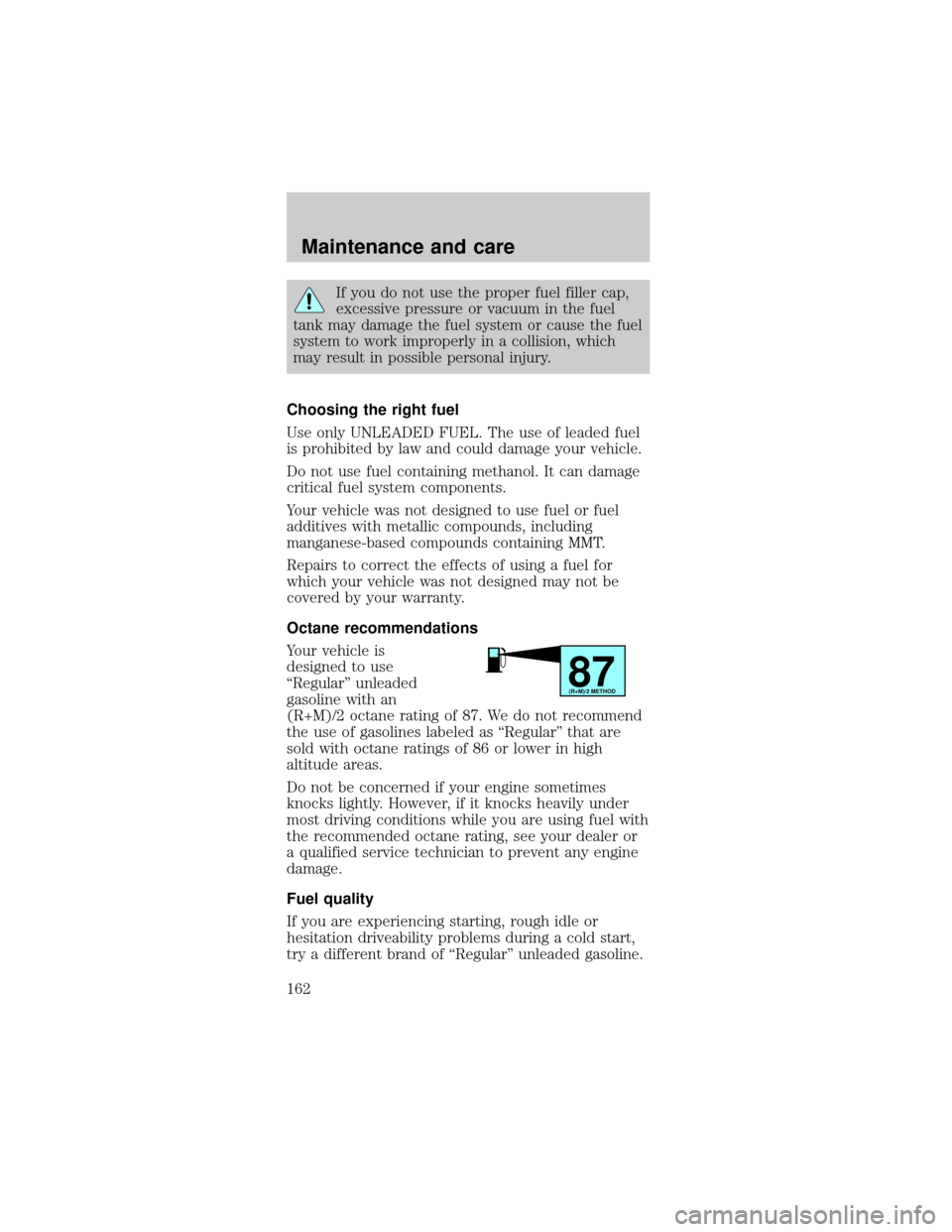1999 FORD MUSTANG maintenance
[x] Cancel search: maintenancePage 158 of 216

The tires on your vehicle have all weather treads to
provide traction in rain and snow. However, in some
climates, you may need to use snow tires and
chains. Use chains on the tires only in an emergency
or if the law requires them.
Follow these guidelines when using snow tires and
chains:
²Chains may damage aluminum wheels.
²Use only Cable Type chains with size P225/55R16
or 245/45ZR17 tires. Use of SAE Class S chains
may damage vehicle.
²SAE Class S chains may be used on P205/65R15
tires.
²Install chains securely, verifying that the chains do
not touch any wiring, brake lines or fuel lines.
²Drive cautiously. If you hear the chains rub or
bang against your vehicle, stop and re-tighten the
chains. If this does not work, remove the chains
to prevent damage to your vehicle.
²If possible, avoid fully loading your vehicle.
²Remove the tire chains when they are no longer
needed. Do not use tire chains on dry roads.
²The suspension insulation and bumpers will help
prevent vehicle damage. Do not remove these
components from your vehicle when using snow
tires and chains.
WHAT YOU SHOULD KNOW ABOUT
AUTOMOTIVE FUELS
Important safety precautions
Do not overfill the fuel tank. The pressure in
an overfilled tank may cause leakage and
lead to fuel spray and fire.
Maintenance and care
158
Page 159 of 216

The fuel system may be under pressure. If
the fuel filler cap is venting vapor or if you
hear a hissing sound, wait until it stops before
completely removing the fuel filler cap. Otherwise,
fuel may spray out and injure you or others.
If you do not use the proper fuel filler cap,
excessive pressure or vacuum in the fuel
tank may damage the fuel system or cause the fuel
system to work improperly in a collision, which
may result in possible personal injury.
Automotive fuels can cause serious injury or
death if misused or mishandled.
Observe the following guidelines when handling
automotive fuel:
²Extinguish all
smoking materials
and any open flames
before fueling your
vehicle.
²Always turn off the
vehicle before
fueling.
²Automotive fuels can be harmful or fatal if
swallowed. Fuel such as gasoline is highly toxic
and if swallowed can cause death or permanent
injury. If fuel is swallowed, call a physician
immediately, even if no symptoms are immediately
apparent. The toxic effects of fuel may not be
visible for hours.
²Avoid inhaling fuel vapors. Inhaling too much fuel
vapor of any kind can lead to eye and respiratory
tract irritation. In severe cases, excessive or
prolonged breathing of fuel vapor can cause
serious illness and permanent injury.
Maintenance and care
159
Page 160 of 216

²Avoid getting fuel liquid in your eyes. If fuel is
splashed in the eyes, remove contact lenses (if
worn), flush with water for 15 minutes and seek
medical attention. Failure to seek proper medical
attention could lead to permanent injury.
²Fuels can also be harmful if absorbed through the
skin. If fuel is splashed on the skin and/or
clothing, promptly remove contaminated clothing
and wash skin thoroughly with soap and water.
Repeated or prolonged skin contact with fuel
liquid or vapor causes skin irritation.
²Be particularly careful if you are taking
ªAntabuseº or other forms of disulfiram for the
treatment of alcoholism. Breathing gasoline
vapors, or skin contact could cause an adverse
reaction. In sensitive individuals, serious personal
injury or sickness may result. If fuel is splashed
on the skin, promptly wash skin thoroughly with
soap and water. Consult a physician immediately
if you experience an adverse reaction.
When refueling always shut the engine off
and never allow sparks or open flames near
the filler neck. Never smoke while refueling. Fuel
vapor is extremely hazardous under certain
conditions. Care should be taken to avoid inhaling
excess fumes.
The flow of fuel through a fuel pump nozzle
can produce static electricity, which can
cause a fire if fuel is pumped into an ungrounded
fuel container.
Use the following guidelines to avoid static build-up
when filling an ungrounded fuel container:
²Place approved fuel container on the ground.
²DO NOT fill a fuel container while it is in the
vehicle.
Maintenance and care
160
Page 161 of 216

²Keep the fuel pump nozzle in contact with the
fuel container while filling.
²DO NOT use a device that would hold the fuel
pump handle in the fill position.
Fuel Filler Cap
Your fuel tank filler cap has an indexed design with
a 1/8 turn on/off feature.
When fueling your vehicle:
1. Turn the engine off.
2. Carefully turn the filler cap counterclockwise 1/8
of a turn until it stops.
3. Pull to remove the cap from the fuel filler pipe.
4. To install the cap, align the tabs on the cap with
the notches on the filler pipe.
5. Turn the filler cap clockwise 1/8 of a turn until it
stops.
If the ªService Engine Soon/Check Engineº indicator
comes on and stays on when you start the engine,
the fuel filler cap may not be properly installed.
Turn off the engine, remove the fuel filler cap, align
the cap properly and reinstall it.
If you must replace the fuel filler cap, replace
it with a fuel filler cap that is designed for
your vehicle. The customer warranty may be
void for any damage to the fuel tank or fuel
system if the correct genuine Ford or
Motorcraft fuel filler cap is not used.
The fuel system may be under pressure. If
the fuel filler cap is venting vapor or if you
hear a hissing sound, wait until it stops before
completely removing the fuel filler cap. Otherwise,
fuel may spray out and injure you or others.
Maintenance and care
161
Page 162 of 216

If you do not use the proper fuel filler cap,
excessive pressure or vacuum in the fuel
tank may damage the fuel system or cause the fuel
system to work improperly in a collision, which
may result in possible personal injury.
Choosing the right fuel
Use only UNLEADED FUEL. The use of leaded fuel
is prohibited by law and could damage your vehicle.
Do not use fuel containing methanol. It can damage
critical fuel system components.
Your vehicle was not designed to use fuel or fuel
additives with metallic compounds, including
manganese-based compounds containing MMT.
Repairs to correct the effects of using a fuel for
which your vehicle was not designed may not be
covered by your warranty.
Octane recommendations
Your vehicle is
designed to use
ªRegularº unleaded
gasoline with an
(R+M)/2 octane rating of 87. We do not recommend
the use of gasolines labeled as ªRegularº that are
sold with octane ratings of 86 or lower in high
altitude areas.
Do not be concerned if your engine sometimes
knocks lightly. However, if it knocks heavily under
most driving conditions while you are using fuel with
the recommended octane rating, see your dealer or
a qualified service technician to prevent any engine
damage.
Fuel quality
If you are experiencing starting, rough idle or
hesitation driveability problems during a cold start,
try a different brand of ªRegularº unleaded gasoline.
87(R+M)/2 METHOD
Maintenance and care
162
Page 163 of 216

ªPremiumº unleaded gasoline is not recommended
(particularly in the United States) because it may
cause these problems to become more pronounced.
If the problems persist, see your dealer or a qualified
service technician.
It should not be necessary to add any aftermarket
products to your fuel tank if you continue to use a
high quality fuel.
Cleaner air
Ford approves the use of gasolines to improve air
quality, including reformulated gasolines that contain
oxygenates up to 10% ethanol or 15% MTBE.
Running out of fuel
Avoid running out fuel because this situation may
have an adverse affect on powertrain components.
If you have run out of fuel:
²You may need to crank the engine several times
after refueling before the system starts to pump
the fuel from the tank to the engine.
²Your ªService Engine Soonº indicator may come
on. For more information on the ªService Engine
Soonº indicator, refer to theInstrumentation
chapter.
Fuel Filter
For fuel filter replacement, see your dealer or a
qualified service technician. Refer to the Scheduled
Maintenance Guide for the appropriate intervals for
changing the fuel filter.
Replace the fuel filter with an authorized
Motorcraft part. The customer warranty may
be void for any damage to the fuel system if an
authorized Motorcraft fuel filter is not used.
Maintenance and care
163
Page 164 of 216

ESSENTIALS OF GOOD FUEL ECONOMY
Measuring techniques
Your best source of information about actual fuel
economy is you, the driver. You must gather
information as accurately and consistently as
possible. Fuel expense, frequency of fillups or fuel
gauge readings are NOT accurate as a measure of
fuel economy. We do not recommend taking fuel
economy measurements during the first 1 600 km
(1 000 miles) of driving (engine break-in period).
You will get a more accurate measurement after
3 000 km±5 000 km (2 000 miles-3 000 miles).
Filling the tank
The advertised fuel capacity of the fuel tank on your
vehicle is equal to the rated refill capacity of the fuel
tank as listed in theRefill Capacitieschart in this
ªOwner Guide.º The advertised capacity is the
amount of the Indicated Capacity and the Empty
Reserve combined. Indicated Capacity is the
difference in the amount of fuel in a full tank and a
tank when the fuel gauge indicates empty. Empty
Reserve is the small amount of usable fuel remaining
in the fuel tank after the fuel gauge indicates empty.
The amount of Empty Reserve varies and
should not be relied upon to increase driving
range. When refueling your vehicle after the
fuel gauge indicates empty, you might not be
able to refuel the full amount of the advertised
capacity of the fuel tank due to the empty
reserve still present in the tank.
For consistent results when filling the fuel tank:
²Use the same filling rate setting (low Ð medium
Ð high) each time the tank is filled.
²Allow three automatic click-offs when filling.
²Always use fuel with the recommended octane
rating.
Maintenance and care
164
Page 165 of 216

²Use a known quality gasoline, preferably a
national brand.
²Use the same side of the same pump and have
the vehicle facing the same direction each time
you fill up.
²Have the vehicle loading and distribution the
same every time.
Your results will be most accurate if your filling
method is consistent.
Calculating fuel economy
1. Fill the fuel tank completely and record the initial
odometer reading (in kilometers or miles).
2. Each time you fill the tank, record the amount of
fuel added (in liters or gallons).
3. After at least three to five tank fill-ups, fill the
fuel tank and record the current odometer reading.
4. Subtract your initial odometer reading from the
current odometer reading.
5. Follow one of the simple calculations in order to
determine fuel economy:
Multiply liters used by 100, then divide by total
kilometers traveled.
Divide total miles traveled by total gallons
used.
Keep a record for at least one month and record the
type of driving (city or highway). This will provide
an accurate estimate of the vehicle's fuel economy
under current driving conditions. Additionally,
keeping records during summer and winter will show
how temperature impacts fuel economy. In general,
lower temperatures give lower fuel economy.
Maintenance and care
165